Introduction
Brief Overview: Defining Local Culture in Architecture and Its Importance
Architecture transcends mere structure—it’s a language that embodies a society’s character, beliefs, and values. Local culture in architecture expresses the traditions, lifestyles, and histories of a community, using local materials, techniques, and symbols. This rooted approach to architecture preserves the uniqueness of a place, celebrating diversity and providing cultural continuity amidst globalization. From England’s red-bricked Georgian buildings to Japan’s intricately carved wooden homes, architecture grounded in local culture adds meaningful character to any region.
Purpose and Relevance: The Importance of Cultural Expression in Architecture
- Historical Preservation: Culturally rooted architecture serves as a historical record, preserving stories and regional practices for future generations. Ancient monuments and traditional homes connect us to our heritage and shared history.
- Cultural Identity: Buildings influenced by culture reflect the identity of their communities. For instance, Middle Eastern mosques and Gothic cathedrals symbolize the values and beliefs of their societies.
- Social Impact: Culturally aligned architecture creates spaces where residents feel connected to their heritage, fostering community pride and supporting tourism, which in turn benefits the local economy.
The Connection Between Culture and Architecture
The Role of Architecture in Cultural Identity
Architecture reflects and reinforces cultural identity, making it an essential element of a community’s self-expression. Every architectural decision—from the layout of a home to the grandeur of a civic building—mirrors the unique societal values, religious beliefs, and social customs of the region. For example, in many indigenous cultures, structures are built with a profound connection to nature, utilizing materials like bamboo, stone, and earth, thereby symbolizing harmony with the environment. In contrast, urban European designs often prioritize durability and grandeur, as seen in the use of materials like stone and brick to showcase stability and longevity.
The influence of local climate and geography also affects how architecture develops, intertwining the environment with cultural expression. In arid Middle Eastern regions, the construction of courtyards and the use of high walls create cooler, shaded areas, providing both privacy and relief from the heat, catering to cultural and environmental needs simultaneously. Such practices speak to a deeply ingrained understanding of the environment and the ways in which architecture can embody local values.
Historical Perspective
Architecture has always been a reflection of societal values. Ancient civilizations, from the Egyptians to the Mayans, infused their structures with cultural and religious meaning. For example, the Egyptians believed in the afterlife, and their architectural prowess is immortalized in the design of the pyramids, which were not just tombs but symbols of divine ascent and everlasting life. Similarly, in India, temples were designed to mirror cosmic principles, with each element—from the placement of statues to the intricacies of the carvings—representing facets of spiritual thought.
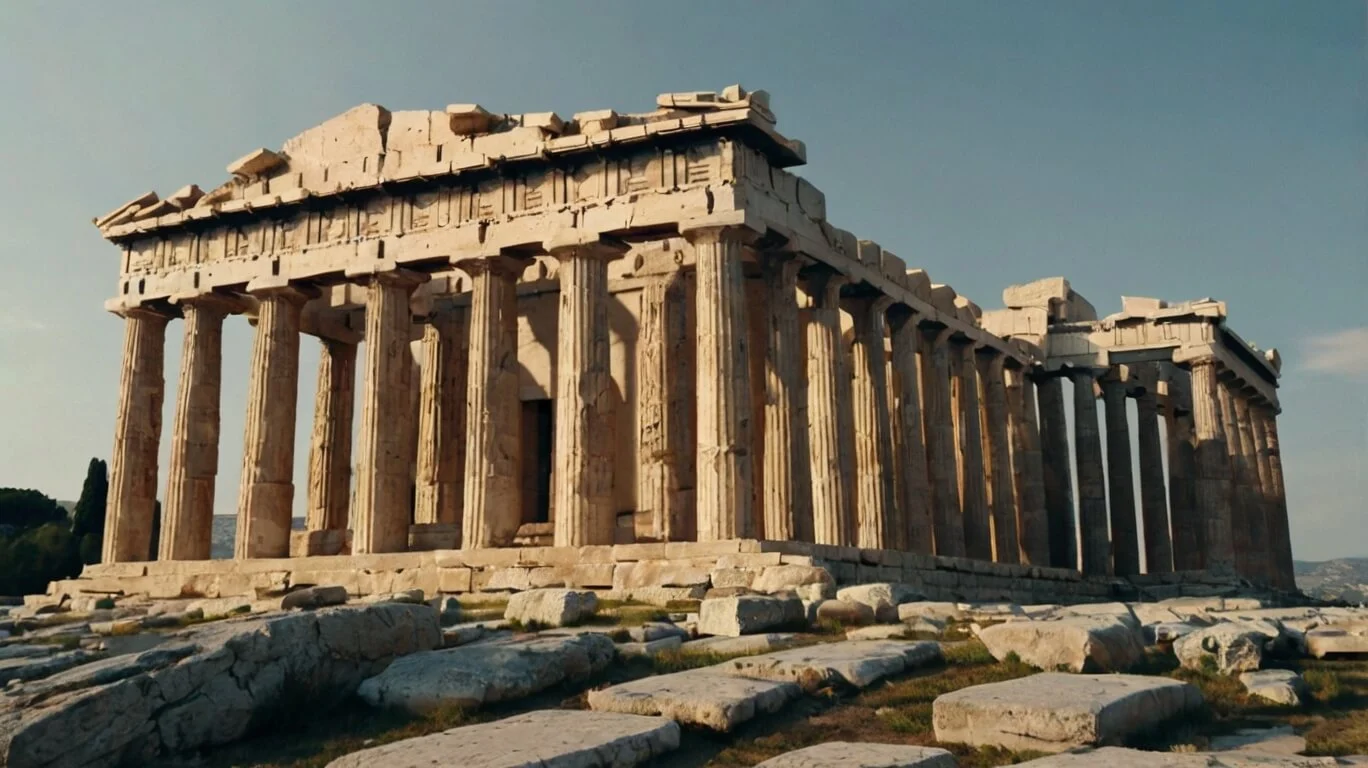
Traditional architecture across the world showcases how deeply embedded cultural values are within construction methods. In Japan, Shinto and Buddhist philosophies emphasize harmony, simplicity, and impermanence, leading to minimalist structures that blend seamlessly with nature. Indigenous American architecture, such as the pueblos in the Southwestern United States, utilized local materials like adobe and stone to withstand the desert climate, reflecting a deep respect for sustainability and resourcefulness.
This historical embedding of culture in architecture fosters a continuity of values, showcasing how architecture has always been intertwined with the spiritual, social, and practical needs of a community.
Influence on Modern Architecture
Even in the modern age, the architecture of a place is not untouched by its cultural roots. Many architects draw inspiration from local culture to create structures that honor tradition while embracing contemporary needs. This trend, often called “vernacular modernism,” merges modern building techniques with local aesthetics, materials, and symbols, allowing buildings to speak to the past while serving current functions.
For example, in the realm of sustainable design, architects are reviving ancient techniques to meet the growing demand for environmentally friendly buildings. Traditional methods like the use of natural ventilation, rainwater harvesting, and passive solar design are being adapted to modern standards, creating buildings that are both efficient and culturally relevant. In places like India, architects have incorporated the concept of the “jaali” (intricate lattice screens) to cool spaces, an approach used in palaces centuries ago to allow airflow while maintaining privacy.
Another contemporary influence is the conscious effort to create culturally significant public spaces. Architects and urban planners are designing spaces that encourage community gatherings and social interaction, inspired by traditional town squares and marketplaces. These spaces not only preserve the social fabric but also stimulate local economies by attracting visitors and promoting local craftsmanship.
Through these examples, we see how local culture continues to influence architecture, even as societies evolve. By respecting and embracing these cultural foundations, modern architecture preserves the rich history and identity of a place, fostering a deeper connection between people and their built environment.
Elements of Culture in Architecture
Architecture serves as a bridge between culture and form, embodying regional values, aesthetics, and needs through distinct choices in materials, symbolism, and spatial organization. Each element reflects not only practical responses to the local environment but also carries deep-seated cultural narratives and social structures.
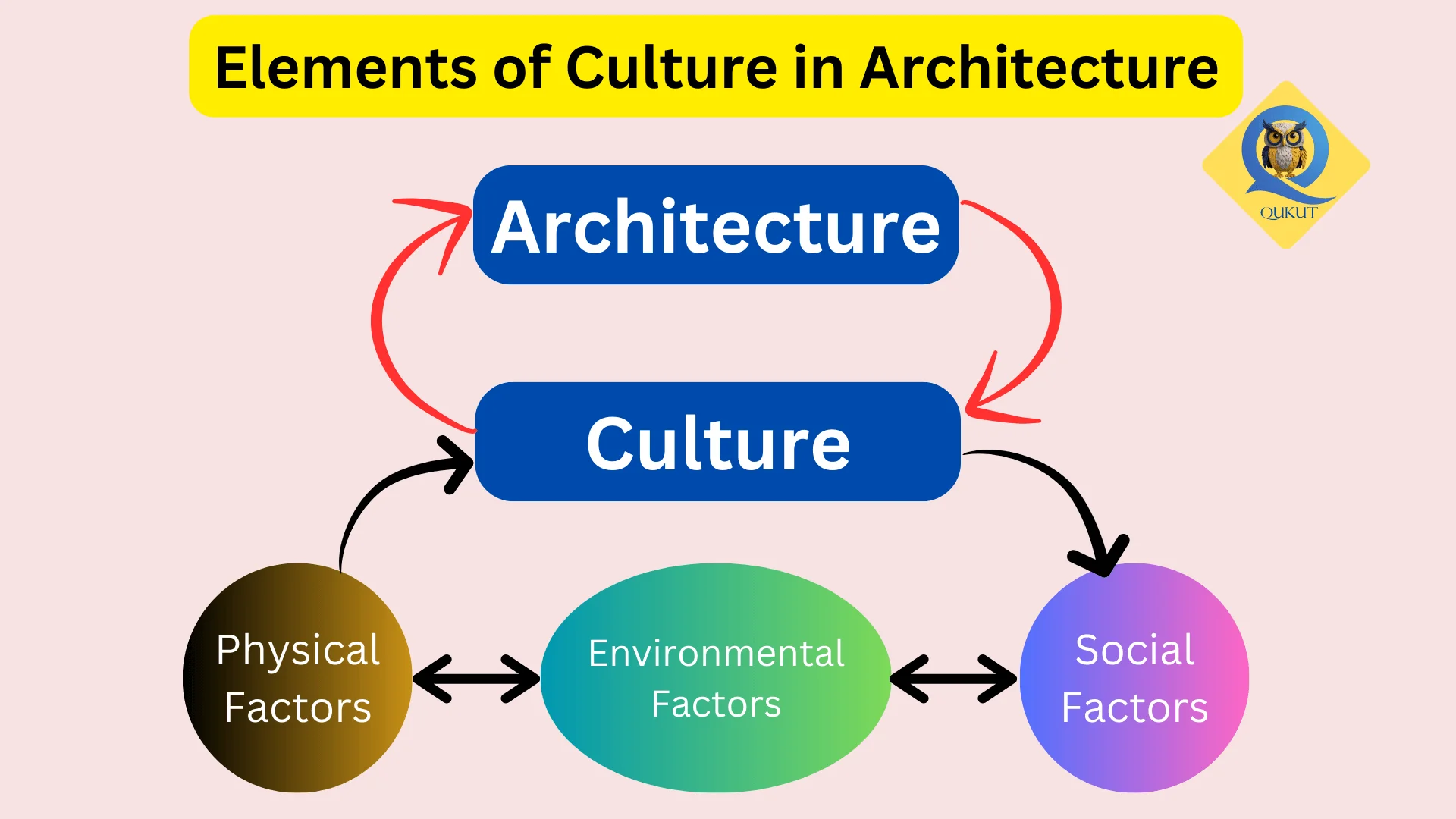
Materials and Techniques
In traditional architecture, materials are not simply functional; they are integral to the cultural identity of a region. The use of locally sourced materials and indigenous building techniques reinforces environmental harmony and cultural continuity:
- Adobe in Arid Regions: Adobe, a mixture of clay, sand, water, and often straw, has been a staple in desert architecture, notably in regions like the American Southwest and North Africa. These materials provide natural insulation, keeping interiors cool in the summer and warm in the winter. Beyond practicality, adobe constructions embody the sustainable values of these cultures, emphasizing resourcefulness and a respect for natural surroundings.
- Bamboo in Tropical Areas: In Southeast Asia, bamboo is abundant, resilient, and sustainable. It is lightweight, easily renewable, and strong—ideal for structures exposed to high humidity and frequent storms. Additionally, bamboo’s organic aesthetic aligns with Buddhist and Taoist values of balance and harmony with nature, making it both a cultural and functional choice.
- Stone and Timber in Temperate Climates: European vernacular architecture in places like the Alps and Scandinavia often features stone and timber. Stone provides durability against cold winters, while timber lends warmth and flexibility in construction. For instance, traditional Norwegian stave churches employ intricate woodworking techniques that symbolize the culture’s craftsmanship and spiritual devotion.
These materials and methods showcase how cultures have historically adapted to their environments while honoring local resources, making architecture a sustainable and culturally expressive practice.
Symbolism and Ornamentation
Architecture often embodies cultural beliefs through symbolism and ornamentation, transforming buildings into canvases of local values, history, and aesthetics.
- Religious and Spiritual Symbols: Across Asia, symbols such as the lotus, dragon, and phoenix are incorporated into architectural elements to signify purity, power, and rebirth. In Islamic architecture, intricate geometric patterns and calligraphy are used to represent divine order, beauty, and the infinite nature of God. These symbols not only embellish structures but also impart spiritual significance, turning places into reflections of faith.
- Regional Motifs and Patterns: Native American tribes, such as the Navajo, use specific patterns and colors to represent elements of their mythology and natural surroundings. These patterns are carved into wood, painted on pottery, or woven into textiles that are part of architectural decor. In Indian temples, the presence of deity statues, floral motifs, and sacred animals, like elephants and peacocks, celebrates the region’s mythological and cultural heritage.
- Structural Ornamentation: In many cultures, decorative elements are not merely ornamental but serve as symbols of wealth, power, or protection. The gargoyles of Gothic cathedrals in Europe, for example, were believed to ward off evil spirits, while intricately carved doors in West African societies signify social status and cultural narratives.
Through symbolism and ornamentation, architecture transcends functional space to become an expressive medium of cultural values and identity.
Building Layouts and Social Norms
Architecture is deeply intertwined with the social structure of a community. Building layouts and floor plans reflect cultural values, social hierarchies, and family dynamics, shaping the way people interact within these spaces.
- Open Courtyards: In Mediterranean and Middle Eastern cultures, open courtyards are central to residential architecture. These spaces provide privacy, ventilation, and a communal area for family gatherings, reflecting a culture that values family cohesion and social interaction within private spaces. The courtyard acts as an oasis, often with water features or greenery, symbolizing tranquility and family harmony.
- Communal Spaces in East Asia: Traditional Japanese homes feature “tatami” rooms that are multi-functional, allowing the space to transform for different family activities. Similarly, Chinese homes, particularly those influenced by Confucian ideals, often include large common areas where the extended family gathers, reflecting the importance of familial hierarchy and communal values.
- Hierarchical Floor Plans: In many cultures, the layout of a home signifies the status of its inhabitants. For example, traditional Indian homes often have separate spaces for guests, elders, and servants, each area signifying social hierarchy. This layout reflects the deep cultural importance of respecting age, status, and gender roles within a household.
These architectural layouts provide insight into the community’s social structure and values, underscoring how architecture is tailored to the human experience within the cultural context.
Case Studies of Culturally Influenced Architecture
Across cultures, architecture is shaped by local beliefs, climates, and materials, making each style uniquely expressive. These case studies illustrate how deeply cultural factors influence aesthetics and functionality.
Asian Architecture
In East Asia, Confucianism, Buddhism, and Taoism have left a profound mark on architectural style, influencing layout, orientation, and spatial arrangements:
- Confucian Influence: Confucian values of hierarchy, family, and social harmony are reflected in the symmetry and central axis of traditional Chinese homes and palaces. These structures emphasize order, with spaces designated for ancestor worship and family gatherings.
- Buddhist and Taoist Influence: Buddhist temples across Asia often blend with natural landscapes, featuring serene gardens and flowing water to foster meditation and reflection. In Japan, Zen-inspired architecture, with its minimalist style and balanced spaces, captures the Buddhist and Taoist emphasis on simplicity and impermanence.
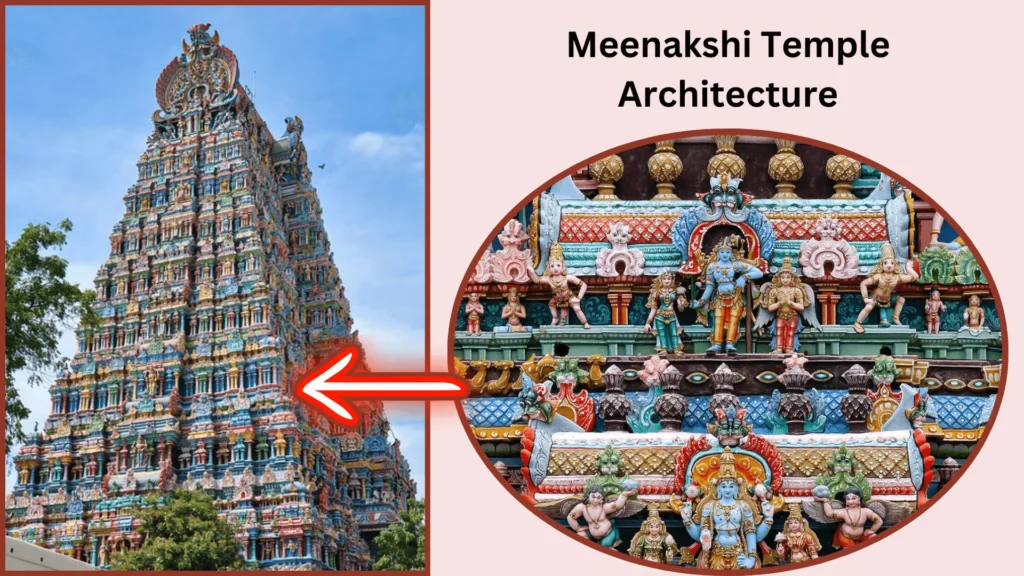
- Indian Architecture: Indian architecture embodies a blend of Hindu, Islamic, and colonial influences, showcasing intricate craftsmanship and spiritual symbolism. Hindu temples are renowned for their elaborate carvings and sacred geometry, while Mughal-era forts and mosques highlight grandeur and symmetry, often incorporating lush gardens and water elements. Colonial architecture adds another layer, with Victorian-style buildings that reflect India’s historical transformation and cultural diversity.
Middle Eastern and Islamic Architecture
Islamic architecture is distinguished by its intricate geometry, symmetry, and decorative elements, which together embody spiritual and cultural principles.
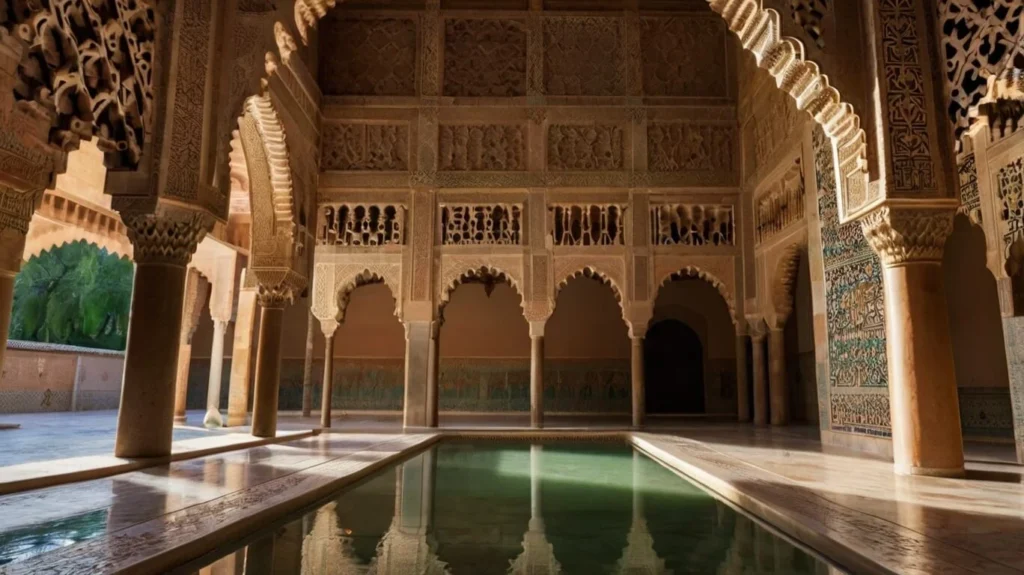
- Geometry and Symmetry: Islamic architecture avoids depictions of living beings, so geometric patterns and arabesques are used to express the infinite nature of Allah. This is seen in the domes, arches, and minarets of mosques, where symmetry reflects divine balance and order.
- Courtyards and Water Features: The traditional Middle Eastern house includes a central courtyard, offering a private, shaded area that provides comfort in hot climates. In religious and public spaces, water features symbolize purity and offer spiritual solace, emphasizing the role of water in Islamic purification rituals.
Indigenous Architecture
Indigenous architecture is often inextricably tied to nature, with designs and materials that reflect a deep respect for the environment.
- Native American Pueblo Structures: Pueblo architecture in the American Southwest uses adobe and stone to create structures that are well-suited to the desert climate. Built with a communal spirit, these structures reflect the values of resourcefulness and community found in Native American societies.
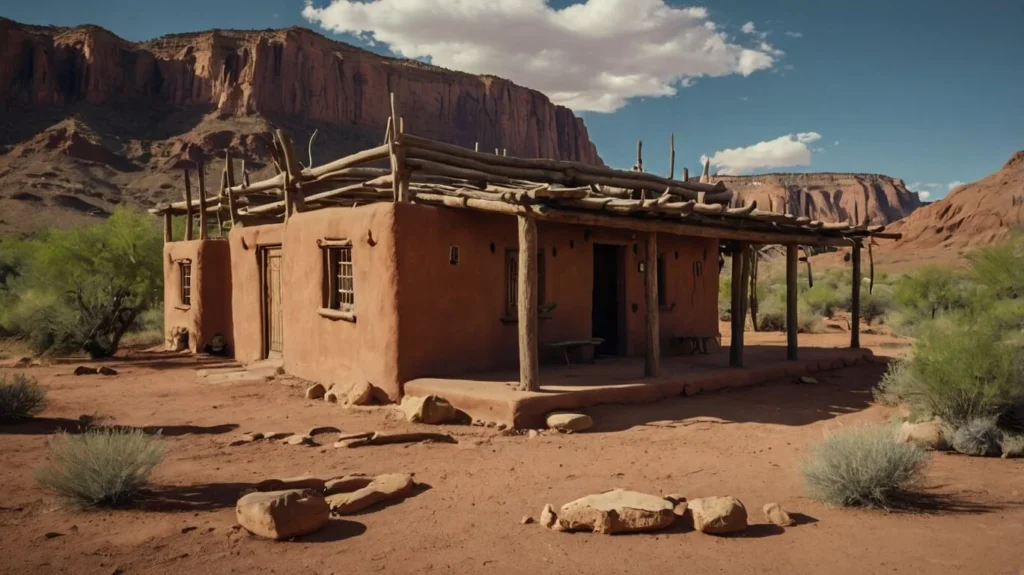
- African Indigenous Huts: In many African communities, huts are constructed from earth, thatch, and timber, blending into the landscape. These structures are often circular, symbolizing continuity, unity, and an inclusive family structure. The layout of traditional compounds supports extended families and promotes social cohesion.
European Vernacular Architecture
Europe’s vernacular architecture has been shaped by climate, religion, and historical events, creating diverse architectural styles.
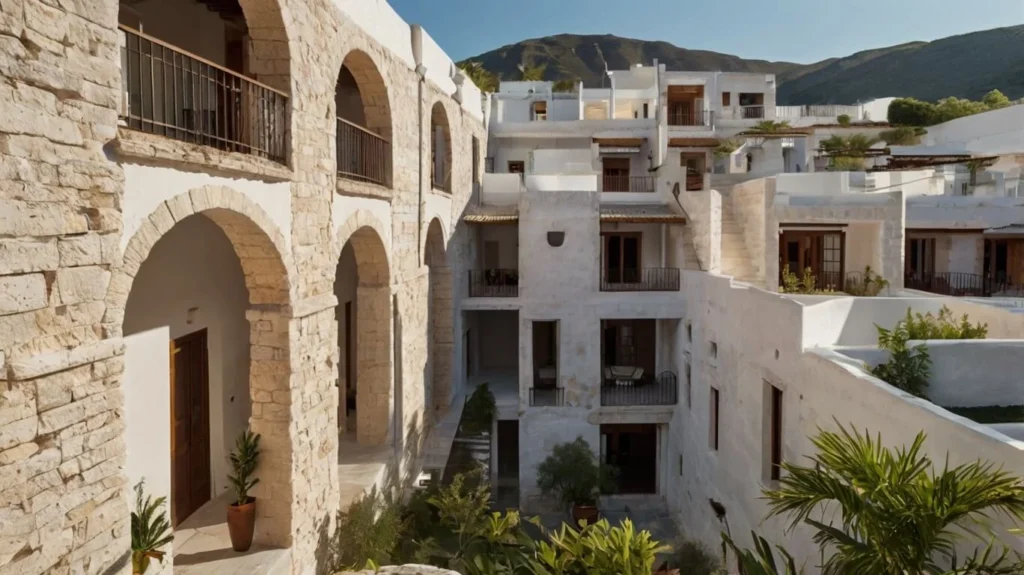
- Mediterranean Architecture: In regions like Greece and Italy, buildings are made with limestone and whitewashed to reflect the heat. Open terraces and courtyards are central features, facilitating ventilation and reflecting the region’s outdoor lifestyle and emphasis on community.
- Gothic and Renaissance Influences: In Northern Europe, Gothic cathedrals, characterized by pointed arches, ribbed vaults, and flying buttresses, reflect a religious fervor that emphasizes upward movement towards heaven. The grand scale and intricate design of these structures underscore the power of the church and its central role in medieval European society.
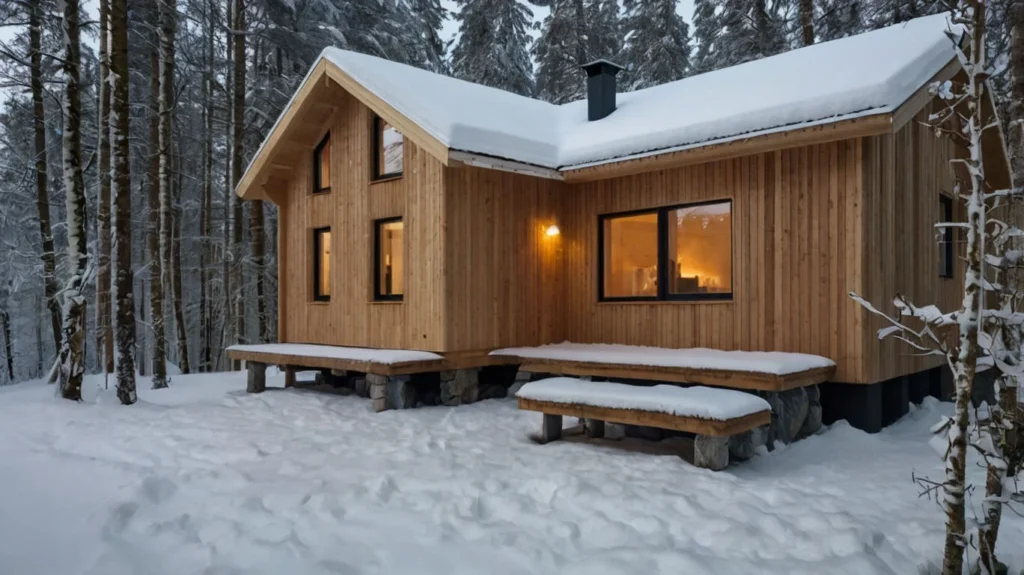
- Scandinavian Architecture: The cold climate in Scandinavia led to timber construction and the use of insulation techniques. Traditional designs focus on simplicity and functionality, emphasizing a harmonious relationship with nature, which aligns with Scandinavian cultural values of practicality and environmental awareness.
Through these case studies, we observe how culture is not only a foundation but also a guiding principle in architectural design, creating structures that honor both tradition and place. Architecture remains an essential vessel for preserving and expressing the unique values, beliefs, and stories of a community, showcasing how deeply culture influences the built environment.
The Impact of Globalization on Local Architecture
Globalization has had a profound effect on architecture, enabling the rapid exchange of ideas, materials, and design principles across borders. While this fusion has brought modern innovations and improved building techniques, it also poses risks to cultural heritage, with traditional practices and styles facing increasing challenges. Here’s a closer look at both the impacts and the responses emerging to preserve cultural identity within a globalized architectural landscape.
Influence of Western Styles and Materials
Globalization has introduced Western architectural styles and materials worldwide, leading to the blending of modern and traditional design elements. This blending often aims to create functional and aesthetically pleasing structures but can also lead to the homogenization of unique architectural identities.
- Modern Materials in Traditional Structures: Materials such as glass, steel, and concrete are now widely accessible and are increasingly incorporated into traditional designs. In Asia, for example, we see skyscrapers with bamboo-inspired structures or traditional roof forms combined with glass façades. This blending respects cultural aesthetics while benefiting from modern innovations in structural durability and energy efficiency.
- Adoption of Minimalist and Modernist Styles: Western minimalist and modernist design principles, which emphasize simplicity and functionalism, have gained popularity across the globe. Many new developments, even in historically rich regions, now feature clean lines, open layouts, and less ornamentation. While this offers a modern look, it may overshadow or alter the traditional architectural narrative unique to each culture.
- The “Global City” Aesthetic: Iconic skylines dominated by glass-clad skyscrapers have become a global phenomenon, giving many cities a visually similar appearance. As a result, regional architectural uniqueness sometimes takes a back seat, as international cities compete to display cutting-edge designs that often look alike, regardless of location.
Challenges to Cultural Preservation
While globalization has promoted architectural innovation, it has also created challenges for cultural preservation, with the risk of erasing unique local identities and practices.
- Loss of Traditional Building Knowledge: As modern construction methods and materials take precedence, traditional building techniques are increasingly at risk of being lost. For instance, indigenous techniques, such as earthen architecture or intricate woodworking, may fall out of use as younger generations shift towards globally dominant practices that prioritize speed and cost-effectiveness.
- Cultural Homogenization: A significant concern in architecture is that globalization leads to a “one-size-fits-all” approach, where international brands and developers prioritize uniform styles that can be replicated globally. This standardization often disregards local cultural nuances, leading to a disconnect between communities and their built environment.
- Economic Pressures: In developing regions, the economic pressure to modernize can outweigh the desire to preserve architectural heritage. Rising land values, urbanization, and tourism can lead to the demolition of traditional neighborhoods, replacing them with contemporary buildings that cater to international markets rather than local residents.
Efforts in Sustainable and Culturally Sensitive Architecture
In response to these challenges, a growing movement in sustainable and culturally sensitive architecture aims to balance modernization with cultural preservation. Architects and developers are adopting more mindful approaches that respect local contexts.
- Using Indigenous Materials and Techniques: To maintain cultural integrity, architects are increasingly incorporating indigenous materials and traditional techniques in contemporary designs. For example, in India, the design of modern resorts in desert regions often integrates local stonework and traditional courtyard layouts to blend with the environment and respect local heritage.
- Environmental Sensitivity and Cultural Respect: Sustainable architecture practices emphasize not only environmental harmony but also cultural respect. Some projects, like Kenya’s “Eco-Village” developments, incorporate local Maasai building techniques alongside modern green technologies. This fusion promotes cultural pride and encourages sustainable living that aligns with local traditions.
- Architectural Movements: Movements like “Critical Regionalism” encourage architects to design in a way that acknowledges the character of a place, using modern techniques while respecting cultural and environmental contexts. This philosophy has influenced many architects worldwide, who now strive to create structures that honor local landscapes, history, and community values.
Role of Architects in Preserving Cultural Heritage
Architects play a crucial role in the preservation and evolution of cultural heritage. They can influence how communities interact with their built environment, balancing the demands of modernization with a respect for tradition. Through thoughtful design, architects can champion cultural preservation, bridging past and present.
Adapting Modern Designs to Fit Local Culture
Modern architecture doesn’t have to disregard cultural values; it can be adapted to reflect local culture thoughtfully and meaningfully.
- Contextualized Design Approaches: Architects can create buildings that respect the spirit of a place by considering local materials, climate, and customs. For example, incorporating vernacular design elements—such as courtyards, sloped roofs, or natural ventilation—creates continuity between new and old while enhancing functionality within the local climate.
- Integrating Cultural Symbols and Motifs: Modern buildings can incorporate symbols and motifs that are culturally significant. An example is the Maori patterns and artwork integrated into contemporary New Zealand buildings, providing a direct link to local heritage and allowing traditional cultural values to thrive in a modern setting.
- Reimagining Traditional Spaces: By reinterpreting traditional architectural elements for contemporary use, architects can foster cultural continuity. In Japan, for example, architects have redesigned the classic “genkan” (entrance space) to reflect traditional aesthetics while accommodating modern lifestyles, preserving cultural identity in a way that suits contemporary needs.
Balancing Innovation with Tradition
Innovation and tradition can coexist, offering communities the benefits of modern technologies without sacrificing cultural identity.
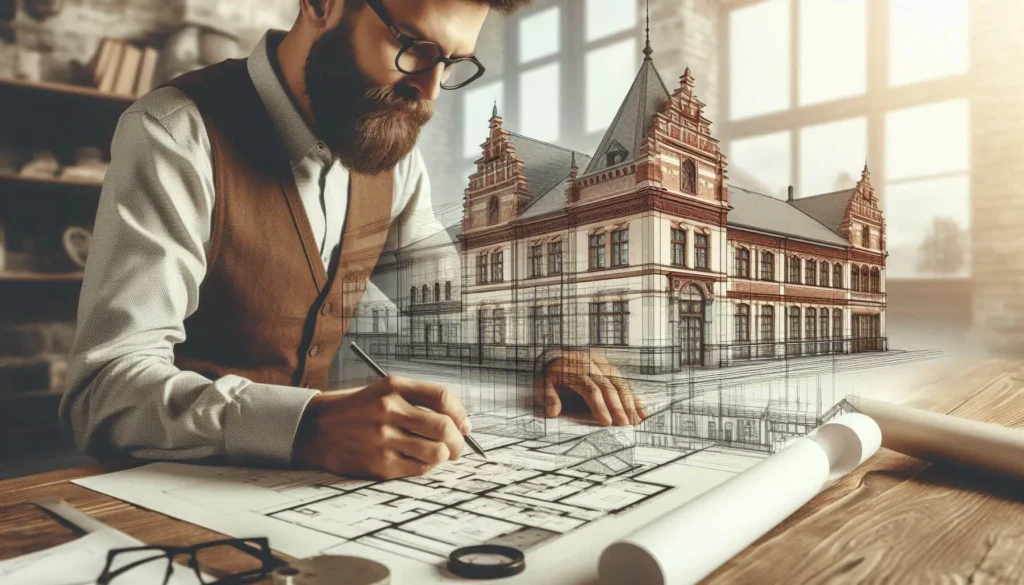
- Hybrid Designs: Architects can blend traditional aesthetics with modern materials and technologies, resulting in hybrid designs that are both functional and culturally resonant. In Morocco, for example, architects have created mud-brick buildings that incorporate solar panels, merging sustainable technology with indigenous materials.
- Adaptive Reuse of Historical Buildings: Adapting historical buildings for modern uses helps preserve cultural heritage while meeting current needs. By transforming old factories, temples, or other historical structures into museums, hotels, or community centers, architects ensure that these culturally significant buildings remain relevant and appreciated.
- Innovative Construction Techniques: Modern construction technologies, such as 3D printing and prefabrication, can be adapted to incorporate traditional materials and motifs. This approach ensures efficiency and durability while respecting cultural aesthetics. Architects in the UAE, for example, have explored the use of 3D-printed sand structures inspired by traditional desert architecture, blending innovation with cultural legacy.
Community Engagement
Architects who engage with local communities can create designs that are not only functional and aesthetically pleasing but also culturally respectful.
- Collaborative Design Process: Community involvement ensures that architectural projects reflect local values and meet the needs of residents. Architects working in indigenous communities, for example, often hold consultations to understand the residents’ preferences, ensuring that the final design respects cultural traditions and supports community well-being.
- Educational Initiatives: Architects can also help educate communities about the value of preserving cultural identity in modern architecture. Workshops, exhibitions, and cultural forums provide spaces for dialogue, fostering an appreciation for architectural heritage and encouraging communities to advocate for culturally sensitive development.
- Empowering Local Craftsmen: Partnering with local craftsmen and artisans can strengthen the cultural fabric of a design. By using local skills for ornamentation, woodworking, or masonry, architects not only ensure the authenticity of the design but also support local economies and traditional crafts.
The Future of Culture in Architecture
As society evolves, so too does architecture, continuing to reflect and shape cultural expressions. With rapid advancements in technology and global connectivity, the future of culture in architecture holds exciting possibilities for preserving and evolving traditional elements while adapting to the modern world. The following sections explore how evolving cultural expressions, technology, and education are helping shape the future of culturally rich architectural design.
Evolving Cultural Expressions
Culture is not static; it evolves, influenced by global connections, technological advancements, and shifting societal values. This evolution is evident in contemporary architecture, where designers blend traditional elements with modern interpretations, reflecting current lifestyles and values.
- Fusion of Old and New: Many architects are finding ways to honor traditional designs while reflecting contemporary tastes. For instance, modern interpretations of classic Japanese Zen gardens can be seen in minimalist, open-layout spaces that promote tranquility while fitting modern needs. Similarly, Scandinavian architecture continues to emphasize simplicity and natural materials, adapted with sustainable practices and innovative design solutions.
- Cultural Hybridity in Urban Spaces: As urban areas become more culturally diverse, architecture reflects this melting pot of influences. Cities like New York, London, and Tokyo showcase structures that incorporate design elements from multiple cultures, celebrating diversity and fostering inclusivity in urban spaces.
- Sustainability as a Cultural Value: Modern architecture increasingly reflects society’s growing emphasis on sustainability, with green buildings and energy-efficient designs becoming more prevalent. Architects are integrating local, renewable materials and designs that harmonize with natural surroundings, blending sustainability with cultural heritage. This trend acknowledges that environmental stewardship is a cultural value essential to many communities, especially indigenous ones.
Technology’s Role in Cultural Preservation
Technology is playing an increasingly important role in preserving and adapting architectural heritage. From virtual reality to 3D printing, modern tools offer ways to document, replicate, and protect culturally significant buildings and elements.
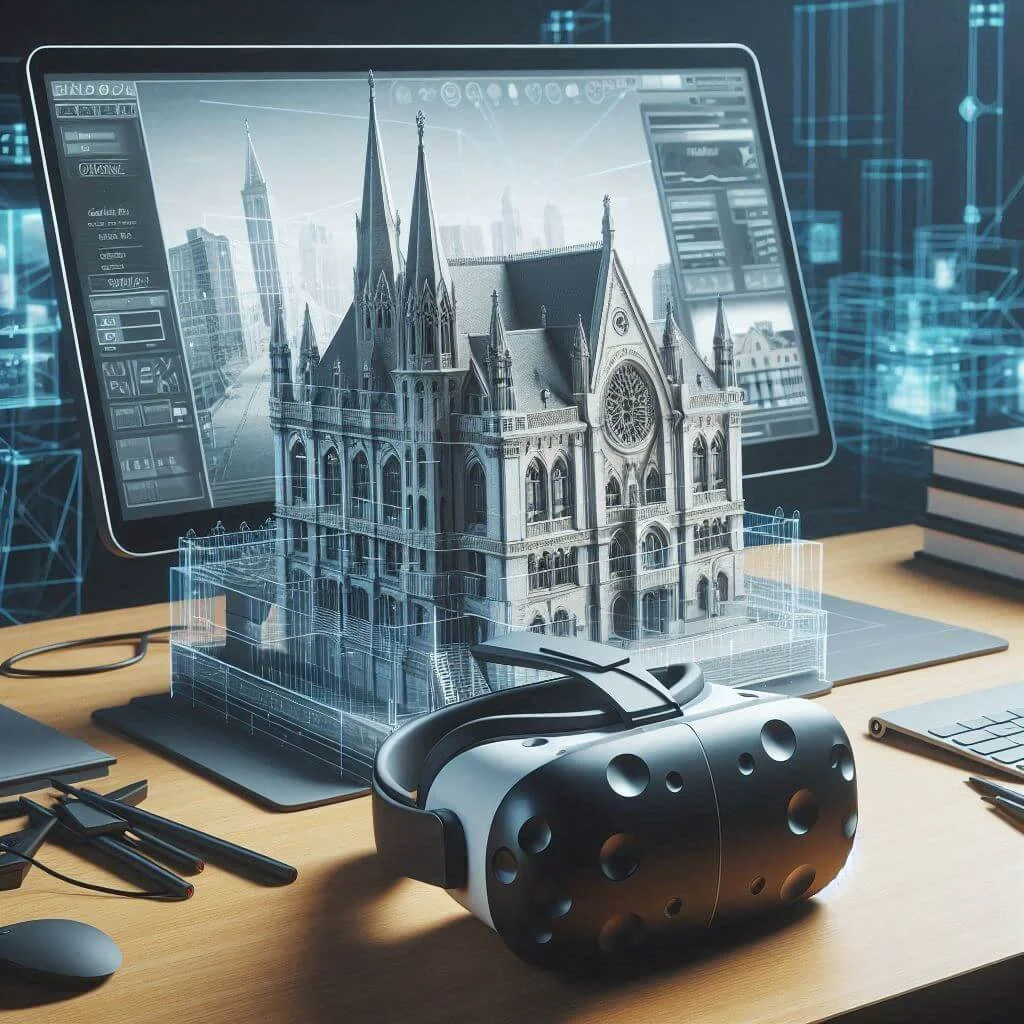
- Virtual Reality (VR) for Heritage Conservation: VR enables architects and historians to document and share architectural heritage with unparalleled accuracy. Through VR, people can explore historically and culturally significant sites that may be physically inaccessible. For instance, VR recreations of ancient sites like the Parthenon or the lost city of Pompeii allow users to experience and appreciate their beauty and significance while preserving the originals from over-tourism.
- 3D Printing in Restorative Architecture: 3D printing offers precise, scalable solutions for restoring historical buildings and structures. Architects can now replicate intricate designs and materials that might otherwise be difficult to source or recreate, ensuring that restorations are as authentic as possible. For example, sections of damaged historical sites can be 3D-printed to match original structures, preserving their cultural integrity while using materials that withstand modern environmental stresses.
- Digital Archiving and Artificial Intelligence: AI and digital archiving are critical tools in cataloging and preserving architectural heritage. AI-powered analysis of building materials, structural designs, and historical documentation allows architects to make informed decisions on preservation techniques. Projects like “The Venice Time Machine” use digital archiving to record the city’s historical architecture, providing valuable data for future restoration and cultural understanding.
Promoting Awareness and Appreciation
Promoting awareness and appreciation for culturally influenced architecture is essential for future generations to understand and preserve their heritage. Educational initiatives and community advocacy play a significant role in this effort, fostering a deeper connection between people and their built environments.
- Architectural Education Programs: Incorporating courses on cultural heritage and traditional design principles in architectural schools can instill a sense of respect for cultural identity in future architects. Through field studies, students gain hands-on experience with local materials and construction techniques, developing an appreciation for the cultural and historical aspects of architecture.
- Community-Led Preservation Initiatives: Local communities are often the most invested in preserving culturally significant structures. Programs that empower residents to advocate for preservation efforts, organize tours, and fund restoration projects can be impactful. These initiatives enable communities to actively participate in safeguarding their heritage, reinforcing a shared sense of identity and pride.
- Public Campaigns and Art Installations: Advocacy groups often use art installations, exhibits, and media campaigns to raise awareness about the cultural significance of architecture. For instance, installations that showcase indigenous materials or traditional motifs can educate the public and draw attention to the importance of cultural preservation, fostering a wider appreciation for culturally sensitive architecture.
Conclusion
The fusion of local culture and architecture is integral to preserving cultural identity, fostering community pride, and maintaining historical continuity. As architecture reflects the evolving values, traditions, and lifestyles of societies, it serves as a bridge between the past and the present. From the traditional use of local materials and unique building layouts to modern adaptations in urban spaces, culturally influenced architecture reflects the rich diversity of human expression.
While modernization has brought significant benefits, it’s essential to balance progress with the preservation of cultural heritage. In a rapidly globalizing world, architecture remains one of the most tangible connections to our cultural roots. As architects, communities, and policymakers work to incorporate cultural elements into modern designs, they honor both tradition and innovation, ensuring that our built environments remain relevant and respectful of cultural identity.
Architecture is about telling a place’s and its people’s story, not only about creating buildings. We each have a role in preserving and celebrating cultural heritage through architecture, whether as architects, community members, or advocates. By supporting culturally inspired designs and preservation efforts, we can ensure that future generations inherit an environment that reflects and respects the diverse histories and values of communities worldwide. Let us all strive to appreciate, preserve, and promote architecture that celebrates cultural identity in our own communities and beyond.



2 Comments